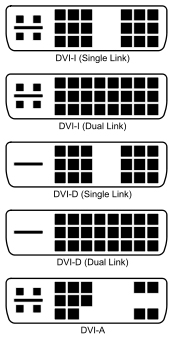DVI™
DVI (Digital
Video Interface) is designed primarily
to connect a computer to an LCD flat
panel monitor, DVI has found
applications in advanced consumer
electronics image devices where it is
used to deliver digital video from a
source to a display. One drawback for
DVI, that is not a major concern with
HDMI, is the length of the connection.
DVI is limited to about 20 feet.
There are three types of DVI connections: DVI-A, DVI-D, and DVI-I.
DVI-A
The
“A” in DVI-A stands for analog. DVI-A
carries a DVI signal to an analog
display such as a traditional computer
CRT.
DVI-D
DVI-D
transfers uncompressed digital video in
its native format between source and
display or between components. DVD-D
precludes the typical digital-to-analog/analog-to-digital
conversions between a computer’s video
card and monitor and provides a higher
quality and faster (wider bandwidth)
interface.
DVI-I
Combine DVI-D and DVI-A on the same cable and you get DVI-I. “I” stands for “integrated”. Please note, DVI-I does not convert a DVI-D to a DVI-A, nor does it work vice versa. It simply enables all 29 pins to conduct so the interconnect is dual use. It wouldn’t be uncommon for a manufacturer to use a DVI-I connector, as this receptacle will allow for the use of both DVI-I and DVI-D cables even if the analog transmission ability is never accessed.
DVI Single Link or DVI Dual Link
DVI uses a digital information format called Transition Minimized Differential Signaling (TMDS). Single link cables use one TMDS transmitter, while dual link cables use two. A single link DVI connection can support a 1920 x 1080 image at 60fps. A dual link connection supports up to a 2048 x 1536 image.
The digital interface uses 24 of the possible 29 pins found on a DVI-I interconnect. A single link DVI cable would enable 12 of those 24 digital pins. A dual link configuration enables all 24. For audio/video applications a single link interconnect is the correct choice. The dual link configuration, while not improving performance on a single link system, will not hinder performance and is interchangeable in that application.
HDMI™
 The
HDMI protocol combines high-definition
video, multi-channel audio, and
inter-component control in a single
digital interface. This lone
interconnect has the ability to transmit
uncompressed digital video and up to
eight channels of audio from source to
display.
The
HDMI protocol combines high-definition
video, multi-channel audio, and
inter-component control in a single
digital interface. This lone
interconnect has the ability to transmit
uncompressed digital video and up to
eight channels of audio from source to
display.
DB13W3
The connector contains 10 standard signal pins and 3 coaxial pins. On the computer side, the pins are female but the coaxial connectors are male. The coaxial connectors carry the video signal split into red, green/gray, and blue; the standard signal pins carry four grounds, three "sense" pins used to communicate with the monitor, vertical sync, horizontal sync, and a composite sync signal.
The 13W3 connector can be converted into a standard VGA connector using cables and adapters that are commonly available. This allows modern Multizyme monitors, which are common on today's computers, to be used with these workstations as long as they are sync-on-green compatible. Likewise, as many newer Sun monitors support multisync, similar cables can be used to connect them to modern computers.
DFP
Digital Flat
Panel (DFP) is a video connector for
flat panel displays. It features 20 pins
and uses the PanelLink protocol.
Unlike DVI, DFP never achieved
widespread implementation. The connector
was used by displays such as the Compaq
Presario FP400, FP500 and 5204. It was
offered on graphics cards such as the Xpert
LCD by ATI Technologies Inc.
BNC
The BNC connector is used for professional video connections, both for analog and Serial Digital Interface signals, This connector is an alternative to the RCA connector when used for composite video on commercial video devices, however many consumer electronics with RCA jacks have been utilized on commercial video equipment with BNC jacks via adaptor.
VGA![]()
The common 15-pin VGA connector found on most video cards, computer monitors, and other devices, is almost universally called "HD-15". HD stands for "high-density", which distinguishes it from connectors having the same form factor but only 2 rows of pins.